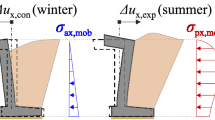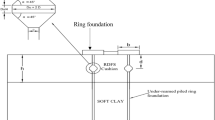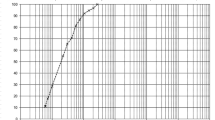Abstract
Shallow foundations resting on a deep layer of soft saturated clay are considered a geotechnical challenge. The design engineer is faced with challenges in selecting safe and economic solutions for the foundations of these light weight structures by turning to the shell-shaped foundations to deal with such foundation problems and avoid the use of the costly deep foundations or other soil improvement schemes. This paper introduces different bottom of foundations shapes resting on extended soft clay layer in an effort to minimize the soil stresses and reduce the settlements. Elliptical, trapezoidal and inverted folded footings have been used as an alternative to the conventional flat bottom shallow footings. The purpose of the current study is to reach the optimal shape of the foundations, which achieves reduced stresses, reduced settlements and consequently cost. The geotechnical behavior of different bottom of foundation shapes resting on saturated soft clay is investigated experimentally and numerically. The experimental investigation started with studying a model for the conventional square flat footing shape resting over saturated soft clay. Elliptical, trapezoidal and inverted folded bottom of foundation models are tested and compared with the reference conventional square flat ones. In addition to the experimental study, a numerical analysis is performed using the finite element software ADINA. Verification of the numerical model is conducted first against the experimental results for all the studied cases. The verified numerical model is then extended to cover full-scale footing sizes of conventional and other studied footing cases and shapes. The optimum bottom of foundation shape is the one that gives the lowest soil stresses and consequently the lowest settlements.



















Similar content being viewed by others
References
Nagaraj TS, Miura N (2001) Soft clay behavior analysis and assessment. A.A. Balkema, Rotterdam
Abdel-Rahman MM (1996) Geotechnical behavior of shell foundations. Ph. D. Thesis, Civil Engineering, Concordia University, Montreal, Quebec
Esmaili D, Hataf N (2008) Experimental and numerical investigation of ultimate load capacity of shell foundations on reinforced and unreinforced sand. Iran J Sci Technol Trans B Eng 32(B5):491–500
Alhassan M, Boiko IL (2013) Experimental study of the effect of foundation shape on settlement and bearing capacity of soils. Int J Eng Technol 3(2):108–114
Kurian NP, Devaki VM (2005) Analytical studies on the geotechnical performance of shell foundations. Can Geotech J 42(2):562–573
Hanna AM, Abdel-Rahman M (1998) Experimental investigation on shell foundations on dry sand. Can Geotech J 35(6):828–884
El-Sakhawy NR, Salem TN, Al-Tuhami AA, Abdelatif AA (2016) Experimental study for the optimization of foundation shapes on soft soil. Egypt Int J Eng Sci Technol 21:24–32
Abdelatif AA (2016) Experimental and numerical study for the optimization of precast foundation shapes on soft soils. Ph.D. Thesis, Department of Structural Engineering, Faculty of Engineering, Zagazig University
Author information
Authors and Affiliations
Corresponding author
Ethics declarations
Conflict of interest
On behalf of all authors, the corresponding author states that there is no conflict of interest.
Rights and permissions
Springer Nature or its licensor (e.g. a society or other partner) holds exclusive rights to this article under a publishing agreement with the author(s) or other rightsholder(s); author self-archiving of the accepted manuscript version of this article is solely governed by the terms of such publishing agreement and applicable law.
About this article
Cite this article
Salem, T.N., El-Sakhawy, N.R. & El-Latief, A.A. Experimental and numerical study for the optimization of bottom of foundation shapes on soft soils. Innov. Infrastruct. Solut. 6, 93 (2021). https://doi.org/10.1007/s41062-021-00455-7
Received:
Accepted:
Published:
DOI: https://doi.org/10.1007/s41062-021-00455-7




